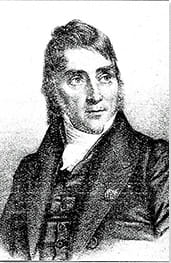Summary of Antoine-Jean Gros
Antoine-Jean Gros rose to national and international fame through a series of dramatic battle scenes, and heroic portraits, featuring Emperor Napoleon. Indeed, Gros is regarded one of the first propagandists for the way his magnificent canvases valorised the Napoleonic overseas campaigns. Arguably the most naturally gifted of Jacques-Louis David's apprentices, Gros went on to enjoy great public and critical acclaim. However, Gros failed to accede to the position of head of the French school after he became heir to David's studio. Gros continued to paint superb portraits, but his later historical paintings, which he painted out of reverence for David's strict academic Neoclassical style, lacked the epic sense of drama and dynamic coloring that had distinguished his earlier works. His reversal of critical fortune notwithstanding Gros is today recognized both as the "painter of Napoleonic France" and as the principal go-between in the transition between the Neoclassical and Romantic movements.
Accomplishments
- While he revered his master, Jacques-Louis David, Gros possessed a fiercely passionate side that tempted him away from strict formal rules of Neoclassicism and more towards the colorful and vibrant styles he so admired in the works of Peter Paul Rubens, Titian, and Tintoretto. By introducing these elements into historical painting, Gros staked his claim as the progenitor of French Romanticism.
- For progressives who admired contemporary war scenes such as those of Francisco Goya, Gros's paintings could be dismissed as little more than propagandist lies. However, Gros's Napoleonic battlefield pictures amount to much more than crude disinformation exercises. Today historians are willing to excuse their dubious historical accuracy, and to focus rather on the unprecedented way in which Gros breathed drama and emotion into these sweeping narratives.
- Gros's most famous painting, Bonaparte Visiting the Pest House in Jaffa, is, in the words of art historian Andrew McClellan "the work of art that more than any other symbolized Napoleonic triumph and the new glory of Paris". This huge tableau stands as the very epitome of the proto-Romantic style and provided a template for greats such as Eugène Delacroix and Théodore Géricault to follow.
- Gros remains best known for his Napoleonic campaign paintings, but his skill as a portraitist, fostered from early childhood by Élisabeth Louise Vigée Le Brun, never lost its lustre, and sustained him even after his fall from critical favor. Admired for their smooth lines and modelling, and a delicate and melancholic quality, his portraits positioned him as heir to the great French classicist (and revolutionary), Pierre-Paul Prud'hon.
The Life of Antoine-Jean Gros
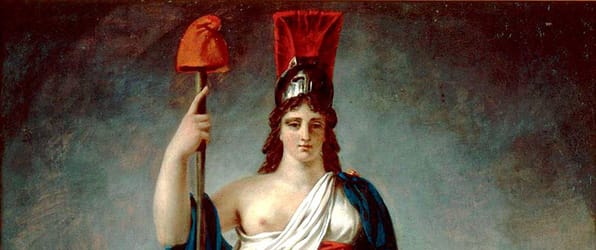
Historian David O'Brien writes, "Gros occupies a special position in the history of art: among the French painters whom we still regularly admire, he is the last to make his reputation working primarily for the government. [...] Gros is an exception. Only Gros managed repeatedly to inject drama into [his] painting".
Important Art by Antoine-Jean Gros
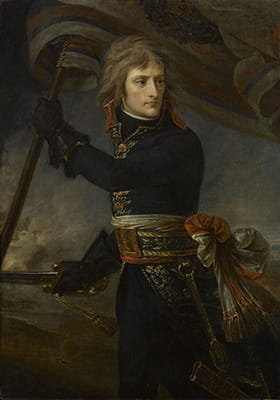
Napoleon on the Bridge at Arcole
In this painting, considered Gros's first major work, the artist depicts an assured-looking Napoleon leading his troops as they storm the bridge at the Battle of the Bridge of Arcole (in Verona, Italy). The French were victorious against the Austrian army due to a bold tactical move by Napoleon. Gros, who was present at the battle, shows Napoleon in three-quarter-length, wearing the dark blue trousers and tunic of a general of the First French Republic. He holds up the flagstaff of the Armée d'Italie in his left hand, and a sword in his right. The forbidding background is obscure and smoky, alluding to recently-fired cannons (a single cannonball lays on the ground behind Napoleon to the left). This work is considered to be one of the first images (if not the first) in the creation of the heroic "Napoleonic myth". However, art historian Andrea Stuart explains how Napoleon had "trouble sitting still for long periods of time" and his wife, Joséphine, who commissioned the painting, had to hold him in her lap to calm him during the several sessions required for the work to be painted.
The dramatic painting demonstrates how, from early on in his career, Gros was guided by strong Romantic sensibilities as much as he was committed to the austere Neoclassical conventions espoused by his esteemed master, Jacques-Louis David. There is very little by way of historical authenticity here. As Historian Roberto A. Scattolin explains, "the blue-clad combatants incurred severe loss in strength and morale; the offensive movement invigorated by Bonaparte's resolution, unexpectedly turned into a bloody massacre where nothing glorious happened for the honour of the French arms". Indeed, while the battle did result in a French victory, they suffered significantly greater losses than the Austrians (some 4800 dead and wounded, versus 2200 in the Austrian ranks), and the battle's "legendary" status in the history books, which marked, as Scattolin writes, "the start of Napoleon Bonaparte's meteoritic rise", was due in large part to its over-glorification in the French news media and in paintings such as Gros's.
Art historian David O'Brien comments that "it is telling that Bonaparte chose to turn the story, despite its potentially embarrassing aspects, into a centerpiece of his propaganda. [...] The Arcole story was useful in its demonstration of Bonaparte's leadership and the loyalty of his soldiers" given that a number of generals had previously failed in their attempts to lead the charge across the bridge. Moreover scholars such as O'Brien, have noted, the myth constructed by Napoleon, and especially Gros's painted version of his heroics, created a parallel with some of the most emblematic stories that exist around other powerful and revered historical figures, including Caesar, Alexander the Great, and Charles the Great.
Oil on canvas - Palace of Versailles
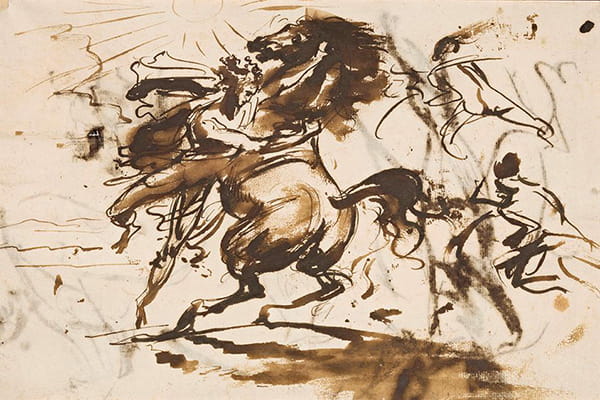
Alexander Taming Bucephalus
This drawing shows ancient Macedonian king Alexander the Great taming his legendary horse, Bucephalus. According to records, the horse was so wild no one dared to acquire him, except for the heroic Alexander. Although he accomplished the feat by calmly speaking to Bucephalus, and moving the animal so that it could no longer see its shadow (the source of its anxiety), Gros presents the scene much more dramatically. It is as if Alexander were more engaged in a physical battle, or even perhaps a dance, with the bucking animal, his muscular arms grasping at its mane, and his body launching off the ground to become entwined with the horse's.
Arts researcher Laura Angelucci notes, "early on, [Gros's] drawings, more so than his paintings, began to reveal a gradual shift away from David's teachings, leading to a definitive break with neoclassical aesthetics and a distinct style heralding the new artistic movement. In his most dramatic drawings, executed in pen and ink, Gros's free, impetuous style and liberal use of wash accentuate the strength and originality of his art". This was one of some forty early drawings by Gros that were exhibited at the Louvre in 2019, an exhibition which, as Angelucci observes, highlighted the artist's sublime draftsmanship "of which the public knows [or knew] very little". Art historian Michael Prodger ranked Alexander Taming Bucephalus to be "One of the most beautiful drawings in the exhibition" calling it "an early, Italian-era attempt to reconcile instinct and painterly decorum" in which "Gros's interest is wholly in the fluidity of movement and the knot made by the two entwined figures".
Brown ink on paper - Musée du Louvre, Paris
Bonaparte Distributing a Sword After the Battle of Marengo
In addition to his history and portrait paintings, Gros proved himself to be an accomplished equine painter. Bonaparte Distributing a Sword After the Battle of Marengo is portrait featuring Napoleon and his most beloved purebred Arabian horse (one of about thirty horses he owned). The painting shows Napoleon at a 1800 troop review at the camp in San Giuliano-Vecchio, distributing awards to the bravest soldiers, two days after the battle. Gros renders the animal as strong and powerful, with its musculature clearly defined and its feathery tail blowing gently in the wind. The painter and critic Etienne-Jean Delécluze, wrote upon viewing the portrait that it was "painted with easy brushstrokes and audacious tints" and proved to be "very appealing to both the public and the young artists". Delécluze added that "David did not hesitate to proclaim in the Salon that this work of quality would make an impact on the development of the Parisian school where color was too much neglected [and that] Girodet, Gérard and all the acknowledged painters were unanimous to praise Gros's achievement".
In 1805, Bonaparte Distributing a Sword After the Battle of Marengo was weaved into a tapestry (by Gobelins Manufactory) to be hung in imperial residences and/or to be given as diplomatic gifts (as was Gros's, Bonaparte Visiting the Pest House in Jaffa and other works by David, Gérard, and Regnault). Napoleonic historian Karine Huguenaud notes that "The vivacity and freshness of the colours [were] particularly well transferred to the tapestry" but that the finished tapestry "did not please the Emperor at all. [...] He wrote in 1806, 'Forbid the Gobelins Manufactory to make copies of paintings which they cannot hope to rival. Let them make hangings and furniture'. Despite the Emperor's misgivings, a tapestry of Bonaparte Distributing a Sword After the Battle of Marengo was presented as a New Years gift to Queen Hortense in 1811.
Gros also received high praise for the white horse he painted at the center of The Battle of Aboukir (1806). The nineteenth-century art critic G. Dargenty (the pseudonym of Arthur Auguste Mallebay du Cluzeau d'Échérac) wrote of "the fury of this peaceful animal, pushed by the cries and the crowd to the paroxysm of exaltation", while artist and writer Jean-Baptiste Delestre stated that Gros's horse "is full of ardor and pride". One of the artist's greatest's admirers, Delacroix, said of the work that Gros "knows how to paint the sweat that floods the rumps of his horses in the middle of battle, and almost the fiery breath that escapes from their nostrils".
Oil on canvas - Chateau de Versailles, France
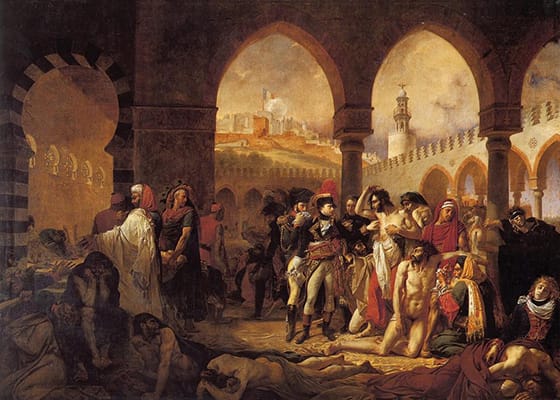
Bonaparte Visiting the Pest House in Jaffa
Gros's most famous painting, Bonaparte Visiting the Pest House in Jaffa, depicts the moment during the French invasion of Egypt, in March 1799, when Napoleon visited his plague-stricken soldiers at the Armenian Saint Nicholas Monastery. The painting shows the Napoleon bravely, calmly, and compassionately, touching one of the sores (or "buboes") of one of the sick men with a bare hand (having removed his white glove). The gesture is reminiscent of both the ancient Greek sculpture, the Apollo Belvedere, and images of Christ healing the sick (thereby equated Napoleon with the "divine healer"). Although we have since learned that the plague couldn't be transmitted by touch, at the time this work was produced, the means of contagion were still unknown, making Napoleon's actions seem rather daring. The emphasize this point, one of his officers stands behind, covering his face with a cloth, presumably out of disgust at the stench and/or fear of infection. Also present in the scene are several other sick men, sitting and lying on the ground, and being treated by doctors following the prescribed methods of the time (such as draining the buboes). One of the doctors in the scene keels over, succumbing to the plague, while still attending a patient. He is believed to represent the surgeon Masclet, a friend of Gros's who did succumb to the plague.
This work, which was exhibited at the Salon of September 1804, was commissioned by Napoleon to help sway public opinion in his favor following British media reports of atrocities committed by the French at Jaffa, and the supplementary story that Napoleon had ordered around fifty his sick men to be euthanized by poisoning with laudanum. Despite this report, the art historian Jennifer Olmsted writes, "Jaffa acted as a major turning point for the use of art as propaganda with its canny manipulation of French suffering to project Bonaparte as a compassionate leader". Indeed, Gros's painting was "a tremendous popular and political success". O'Brien argues, in fact, that this work alone "secured Gros's reputation and at the same time established the form of history painting for which the [French] Empire is remembered".
When the painting was first exhibited, Vivant Denon, Director-General of Museums, wrote the following in a letter to Napoleon: "This painting is truly a masterpiece; it is so much greater than anything that Gros has done previously, that by this work alone he will rank amongst the most outstanding artists of the French School". Art historians Beth Harris and Steven Zucker identify Gros's huge tableau as a "proto-Romantic painting that points to the style of Gericault and Delacroix". They observe how, moreover, "Gros uses warm, sensual colors and focuses on the dead and dying who occupy the foreground of the painting [and that we] see the same approach later in Delacroix's painting of Liberty Leading the People (1830)".
Oil on canvas - Musée du Louvre, Paris
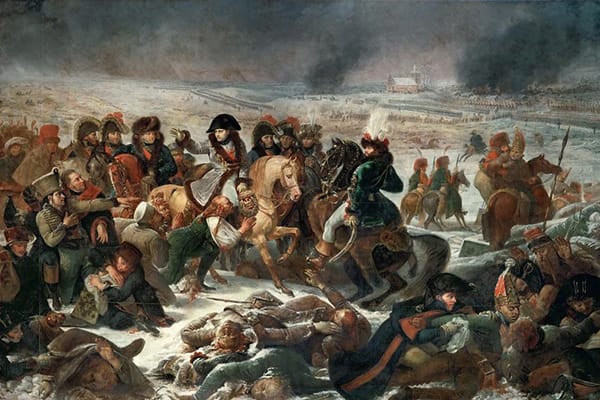
Napoleon on the Battlefield of Eylau
Gros's last significant Napoleonic history painting, shows the Emperor surveying the battlefield after the Battle of Eylau (which took place over two days in February 1807). The battle was, according to military historian David Chandler, "the nearest thing to a defeat Napoleón had experienced since his repulse before Acre in 1799". Although Napoleon's Grande Armée defeated the Imperial Russian Army, they sustained enormous losses (an estimated 25% more casualties, in fact, than the Russians), and for perhaps the first time, the myth of Napoleon was being questioned. Visual documentation of the event couldn't be entrusted to a novice, and Napoleon put then-director of the Louvre, Vivant Denon, in charge of commissioning an established artist. Denon announced a contest, and twenty-six artists submitted sketches for consideration. Gros, who had a longstanding relationship with Napoleon but was reluctant to enter the competition (only to be pressured by Denon), was declared the winner. Gros was not permitted much creative leeway, with Denon dictating everything from the huge format (including double life-size figures) the number of dead bodies and the number of "supporting players" (or "extras").
In the center foreground of this monumental work, the viewer is confronted head-on with a pile of corpses, while a number of wounded soldiers writhe in agony. Also included are Lithuanian and Russian soldiers pledging allegiance to Napoleon while having their wounds bandaged by French medics. This was an almost farcical inclusion given that it was well-documented that medical supplies were in very short supply and that Napoleon gave express orders not to tend to wounded enemy soldiers. At the near center frame, and prominently illuminated, Napoleon sits atop a dun-colored horse, his gaze directed upwards, and his arm stretched out toward his soldiers in the sort of Christ-like gesture. His "consoling" expression, wrote Denon, "seems to soften the horrors of death and spread a softer light on this scene of carnage".
O'Brien writes, "After the battle the army was rife with anger over the butchery [and] even if French citizens did not experience war firsthand, they knew someone who did. [...] At another moment, Napoleón might have suppressed all negative representations of his campaigns, but the disaster at Eylau provided him with a shocking and rare military setback at a moment of rising discontent with the war effort". Duke Raymond Eymery Philippe Joseph de Fezensac, who served under Napoleon at Eylau, said of Gros's depiction of the event that it "can only give a vague idea [of the battle]. He at least paints the effect of those streams of blood spread across the snow with dreadful truth". Indeed, O'Brien suggests that despite its propagandist leanings, the painting offered enough of the horror of war to allow "viewers considerable latitude to explore some of the most disturbing aspects of the subject. [The] painting invited viewers, in a limited way, to exercise their own judgment".
Oil on canvas - Musée du Louvre, Paris
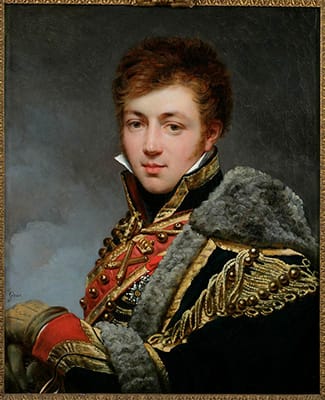
Portrait of Count Honoré de La Riboisière
After 1810, Gros's critics felt his history paintings failed to live up to the standards of his earlier works. It was his later portraits, including Portrait of Honoré-Charles Baston de La Riboisière, that sustained his career (and saved his faltering reputation). Indeed, Gros had long been respected for his portraiture, which comes as little surprise considering that both his parents had been miniaturists, and he was coached at an early age by Élisabeth Louise Vigée Le Brun (his lifelong friend). Moreover, his mentor, Jacques-Louis David, was himself an accomplished portraitist.
The subject of this near half-length portrait, Honoré-Charles Baston (Count of la Riboisière) was the son of General Jean Ambroise Baston de la Riboisière, a famed general of artillery of the First French Empire who fought in the French Revolutionary Wars and the Napoleonic Wars. Honoré-Charles Baston was twenty-seven years old at the time this portrait was painted, although, as The Sterling and Francine Clark Art Institute notes, "he was already a seasoned veteran of several military campaigns". Honoré-Charles's father (and his younger brother) had died three years prior, suggesting that the portrait (which was commissioned by the sitter's mother) was intended to commemorate his own military career. Honoré-Charles had in fact participated in the campaigns of the Grande Armée as aide-de-camp to his father, between 1809-12, and then, in 1813, he became chamberlain to the Emperor.
In this portrait, the subject rests his gloved hands on the hilt of his saber and wears a pelisse trimmed with grey fur and gold, to which is pinned the Legion of Honour. In 1867, artist and writer Jean-Baptiste Delestre was in little doubt about Gros's talent as a portraitist. He wrote: "His head is uncovered; his gaze, full of finesse and kindness, is directed towards the spectator; [...] the facial features are richly studied; their expression offers an indescribable charm. The flesh pulsates with life and youth. The modeling, easy and sustained, seems to belong to the [figurative] Prud'hon school, for smoothness. This artist was deeply struck by the superior talent spread on this small canvas [...] It is, in fact, one of Gros' most graceful and complete productions".
Oil on canvas - Private collection
Biography of Antoine-Jean Gros
Childhood and Early Training
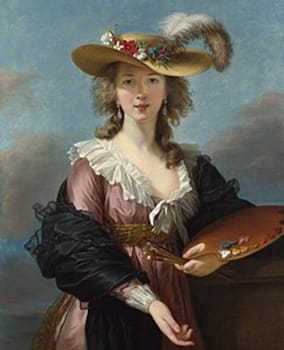
Antoine-Jean Gros inherited his early love of drawing from his parents, Jean-Antoine Gros, and Pierrette-Madeleine-Cécile Durand, who were both successful miniature portrait painters. Young Antoine received further guidance and encouragement from Élisabeth Louise Vigée Le Brun, a sophisticated portraitist, and close friend of the Gros family, who was to become world famous for her portraits of Queen Marie-Antoinette. (New York's Met Museum suggests that this influence might have become reciprocal with Le Brun's "beautiful composition", Study for the Portrait of Princess Antoní Henryk Radziwill (1801) bearing a "striking likeness" to Gros's portait, Madeleine Pasteur (1796)).
In 1785, the fourteen-year-old Gros entered the famous atelier of Neoclassicist, Jacques-Louis David. At the same time, he attended classes at Collège Mazarin. Although Gros held David in the utmost esteem and acknowledged him as an important mentor (he maintained a strong relationship with him throughout his life), Gros found David's Neoclassical style too restrictive for his passionate sensibilities. Stylistically Gros was drawn to the energetic brushwork and vivid color of artists like Peter Paul Rubens, Titian, and Tintoreto. In 1787, Gros joined the French Académie Royale de Peinture et de Sculpture where he worked extensively with live models.
When his father passed away in 1791, Gros was required to earn his own living and devoted himself mostly to portrait commissions. The following year he competed for the Prix de Rome scholarship although his entry was unsuccessful. Gros's career still continued to develop, however, and a recommendation from the Académie des beaux-arts earned him a number of commissions to paint portraits of members of the National Convention, an assembly that governed France for three years following the overthrow of the monarchy in 1792.
In 1793, Gros, deeply troubled by the heightened levels of political violence in Paris, left France and headed for Italy. He travelled to Rome and Florence before settling in Genoa. Art historian David O'Brien explains that "Gros's first years in Italy were miserable. In Florence he lived in penury, unable to support himself on the few portrait commissions he could find, and by June 1794 he was destitute. The French plenipotentiary [minister] in Florence, François Cacault, paid off his debts and sent him home by way of Genoa, where he received the news of David's imprisonment. Realising that his status as a promising student of David no longer carried its former guarantees and that there was little work available in Paris, he decided to stay in Genoa hoping to earn money for his widowed and bankrupt mother by painting portraits and miniatures".
In a letter to his mother, Gros wrote, "Please don't talk to me anymore about reputation, about what is expected of me, and about what those who have seen some of my faces are willing to report since I am reduced to that and I must not fool myself anymore. Such cheerful hopes were only natural to have in Dad's time. Everything and everything has changed since then".
Mature Period
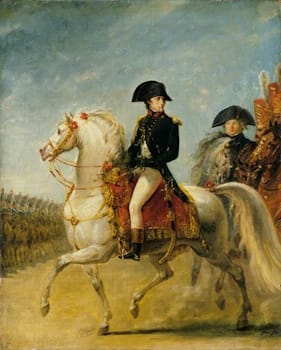
In November 1796, Gros was introduced to Napoleon's wife, Joséphine Bonaparte, who was passing through Genoa en route to Milan, by Minister of Finance, Guillaume-Charles Faipoult. Gros made a strong first impression on Joséphine and she invited him to come to Milan to meet her husband. Nineteenth-century artist and writer, Jean-Baptiste Delestre who studied under Gros, wrote "Josephine was like a tutelary angel with Gros; she never missed any opportunity to serve and encourage him. He was part of the Bonaparte family, the Serbelloni house". Gros was soon thereafter made a member of the general's court and commissioned to paint Napoleon at the Battle of Arcole in 1797. Pleased with the work, Napoleon appointed Gros "inspecteur aux revues" which enabled him to follow the army.
Also in 1797, Napoleon nominated Gros to join the commission responsible for stripping Italian churches and palaces of works of art (which then found their way onto the walls of the Louvre). O'Brien writes that "Bonaparte attached enormous importance to this project. He specified confiscations in peace treaties, spoke often of his conquests in letters released to the press,, and even paid for the shipment of seized works to Paris. Gros's first reaction to the appointment was surprise, since it placed him in the company of such established artists and intellectuals as Jean-Guillaume Moitte, Claude-Louis Berthollet, and Gaspard Monge. [...] Thus, Gros came to participate in what was, for the Parisian public, the most visible result of Bonaparte's Italian campaign".
Gros joined a military convoy travelling from Milan to Genoa in the Spring of 1799. But, as O'Brien explains, once back in Genoa, Gros "witnessed the starvation and disease caused by the long siege of the city where thirty thousand people died in four months. Gros himself suffered from severe malnutrition and fell ill. Barely able to walk, he escaped the city aboard a British vessel on 5th June 1800". By the time Gros arrived in Antibes he was close to death but mustered the strength and fortitude to make it on to Marseille. After about six months of recuperation, Gros relocated to Paris, believing that his years of service to Napoleon would best benefit him in the capital. In 1801 he set up home in an apartment on the grand Boulevard des Capucines.
Despite his friendship with Joséphine, Gros's relationship with Napoleon remained somewhat impersonal. It was a reluctant Napoleon who had sat for Gros over several sessions in Milan in preparation for Bonaparte Crossing the Pont d'Arcole (1796). However, after the painting was exhibited in the Salon de Paris in 1801, Napoleon quickly came round to the idea that art could be a useful tool in promoting his image as a military hero amongst the French public. The Foundation Napoleon says of Bonaparte Crossing the Pont d'Arcole, "The first emblematic image of the Napoleonic myth, this painting exalts the virtues of the military leader, as embodied by the young General Bonaparte at the head of the Armée d'Italie. In reality, Arcole bridge was not crossed. But that is not important. Here the artist glorifies the episode and makes it part of the legend. Drive, courage, overpowering will pour out of this edgy yet passionate picture. [...] What Gros highlights is the image of Bonaparte as the providential saviour, the conquering hero who leads his troops, sabre in hand, seizing victory through his bravery alone".
In 1802, a preparatory sketch Gros made for the painting of the Battle of Nazareth, won him a prize from the consuls. The composition would, however, never be turned into a painting. The reason for this has been attributed to the theory that Napoleon was jealous of the featured general, Jean-Andoche Junot, and because critics and jurors accused Gros of receiving "official favoritism" (rather than on the strength of its artistic merits). It was a temporary setback since, soon thereafter, Gros was commissioned to paint his most famous and critically revered work, Bonaparte Visiting the Plague Victims of Jaffa, which debuted at the Salon in 1804. Depicting a compassionate Napoleon during the campaign in Egypt, the painting effectively secured Gros's reputation. By 1808 Gros had become France's most honored painter. On October 22, 1808, Napoleon made Gros a member of the Legion of Honour. However, by 1810 Gros had fallen out of Napoleon's favor.
Late Period and Death
After David's exile in 1815, Gros took over charge of his former master's large studio, which, under David's leadership, had been considered the country's seat of advanced painting. Gros tutored several students, including a class at the École des Beaux-Arts. Although he did not have a strong reputation as a tutor, Gros was by now greatly admired for his animated use of color, and on one occasion told a class of students, "You are not sufficiently concerned with color, my dear sirs. Yes, it's color which gives poetry, life and charm - no painting can come to life without it". Gros was awarded the Order of Saint Michael in 1819 (an honor bestowed in recognition of distinguished service in foreign countries) but his reputation was staring to slide. Indeed, his retreat into a more studied and sober Neoclassical style, a conscious move by Gros to honor the legacy of David, failed to win over critics.
Historian, Séverine Sofio writes, "Until his former master's death, in 1825, Gros remained deeply devoted to [David]. In their correspondence, he even appears irresolute and terribly insecure, waiting for David to confirm his pedagogical choices or to make decisions for him concerning the subject for his next painting. If David's shadow was still haunting the art world around 1820, two of his former students were actually dominating it: [Anne-Louis] Girodet was clearly the most consecrated history painter whereas [François Pascal Simon] Gérard was the most influential artist thanks to his official titles and his famous and very selective salon. Girodet's death in 1824 and Gérard's forced retirement soon afterwards thus left some room for [Jean-Auguste-Dominique] Ingres: thanks to his singular style and gifted students, Ingres was the new key figure in the art world".
Despite the lukewarm reception of his history paintings, It was generally agreed that Gros continued to produce excellent portraits and he was appointed portrait painter to the new King, Charles X, in 1824. Gros's portraits saw him compared favourably to (the recently deceased) Pierre-Paul Prud'hon. He too was a leading history painter who was known equally for his portraits (Prud'hon painted portraits of Napoleon's two wives). His "luminous life studies" were revered for their subtly of light and shade and for a certain ethereal and melancholic quality and these were qualities of Gros's portraits (Prud'hon, like Gros, suffered from intense bouts of depression).
In 1824 Gros painted the ceiling of the Egyptian room of the Louvre and had the title of Baron bestowed upon him (he was known henceforward as "Baron Gros"). However, Sofio looks past the idea that Gros's history paintings suggested an artist who had simply abandoned the principles that had brought him fame. Indeed, Sofio argues that Gros possessed a principled bloody-mindedness to be admired. He writes, "[At] the Salon, Gros kept playing according to the old rules and refused his colleagues' usual trick of opportune delay in the delivering of their main artwork to the exhibition, or their sometimes obvious strategies to win over the critics and the public. [Gros's] will to stay in the purest Davidian path and fight the Ecole française's [fashionable] "strayings," has something of the nature of a true 'artistic courage,' which seems rather paradoxical considering the constant doubts and insecurity he showed in his letters to David".
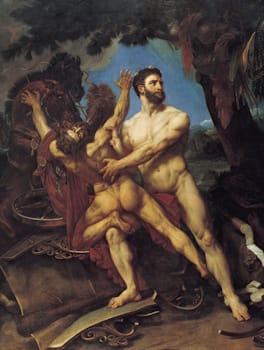
Gros's last painting, Hercules and Diomedes, saw him return to the "old" Neoclassical style, with its restrained colors and mythological subject matter. The painting was harshly criticized at the 1835 Salon, which only added to Gros's growing melancholy. Sofio writes, "From the 1830s onwards, Gros had lost most of his students and every Prix de Rome went to Ingres's atelier. The rivalry between the two painters's ateliers was well known, so Ingres's appointment as the director of the French Academy in Rome in 1835, was probably a bitter defeat for Gros, especially since his main painting, Hercule et Diomède, for the Salon this same year had not received the critical attention he wished for, and was not acquired by the State. How could he not feel that he failed the mission he made his own, to preserve the Davidian heritage and pass it on to younger generations?".
With his marriage, and mental and physical health in decline. Gros ended his own life by drowning in a shallow branch of the Seine at Meudon, on June 25, 1835. He left behind a note stating that he was "tired of life and betrayed by the last faculties which rendered it bearable". Considered at the time a rather "feminine", "unheroic", mode of suicide, Gros's family tried to hide the fact that he had died by drowning. The truth was only officially established in 1880, by Justin Tripier-LeFranc in his biography of Gros.
Vigée Le Brun was deeply affected by Gros's suicide, having seen the man she had known since he was a boy only the previous day. She had once said of her friend, "[he] was always a man of natural impulses. He was prone to feel the keenest sensations and would become equally passionate over a kind action or a beautiful work of art. He was ill at ease in society, rarely breaking the silence in a crowded place, but he listened attentively and replied with his gentle smile, or by a single word, always very apt. [...] His conversation was even more fascinating because he never expressed himself in the same way as other men; always finding the most unusual and powerful images to convey a thought, you might almost say he painted with words".
The Legacy of Antoine-Jean Gros
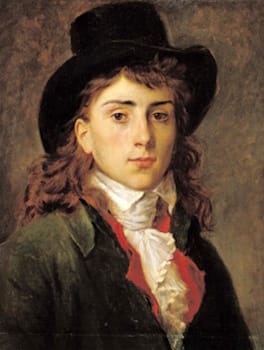
Art historian's such as Michael Prodger have suggested that Gros "remains an underappreciated painter" when one considers his vital contribution to late-18th - early-19th century French art. Indeed, with signature pieces such as Bonaparte Visiting the Plague-Stricken in Jaffa (1804), and Napoleon on the Battlefield of Eylau (1808), Gros did more than any other artist of the period to propagandize the Napoleon legend. But his eye for dramatic embellishment, helped by a feel for the emotional power of color, has seen some credit Gros with halting history painting's demise. As O'Brien explains, "In general, the more history painting assumed the dutiful role Napoleon assigned it, the less it generated critical interest. [...] Only Gros managed repeatedly to inject drama into such painting".
Today critics are more disposed to look past the paintings' historical embellishments, and Gros is widely recognized as the most important figure in the transition from Neoclassical to Romantic eras. There was an element of restrained swagger to Gros's Napoleon works that was picked up on by next generation greats such as Théodore Géricault and Eugène Delacroix, not to mention two of Gros's own pupils, Richard Parkes Bonington and Paul Huet. Perhaps the greatest endorsement of Gros came from Delacroix himself when he wrote (towards the end of his life), "I idolized Gros's talent, which still is for me at the time of this writing, and after everything that I have seen, one of the most remarkable in the history of painting".
Influences and Connections

-
![Élisabeth Louise Vigée Le Brun]() Élisabeth Louise Vigée Le Brun
Élisabeth Louise Vigée Le Brun - François Gérard
- Anne-Louis Girodet
- Alexandre Berthier
-
![Eugène Delacroix]() Eugène Delacroix
Eugène Delacroix -
![Théodore Géricault]() Théodore Géricault
Théodore Géricault - Richard Parkes Bonington
- Paul Huet
-
![Élisabeth Louise Vigée Le Brun]() Élisabeth Louise Vigée Le Brun
Élisabeth Louise Vigée Le Brun - François Gérard
- Anne-Louis Girodet
- Alexandre Berthier
 Ask The Art Story AI
Ask The Art Story AI